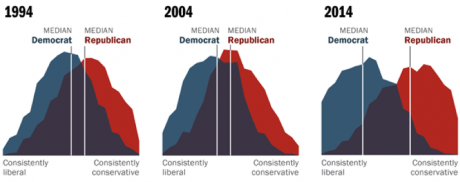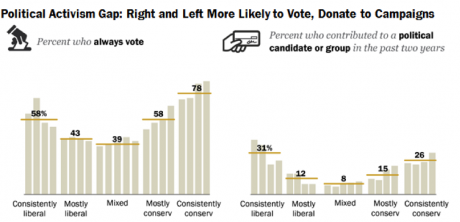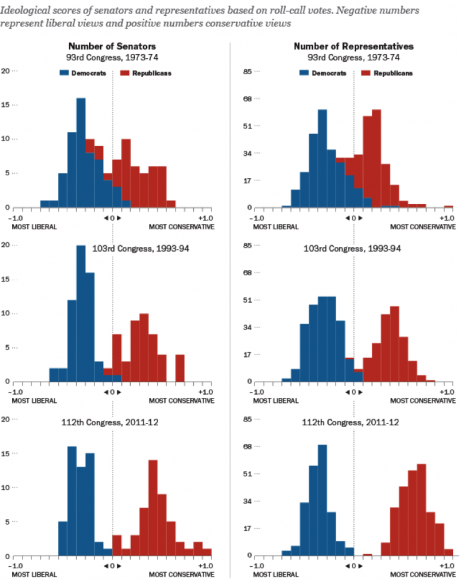Gridlock nation: US politics takes a hardline turn
New York
The rancorous partisan gridlock that shut down the US government last year could become an increasingly common occurrence as America’s citizens and, in turn, their representatives split further along political lines.
American politicians themselves are only now waking up to this reality, with the shock ouster last week of House Republican leader Eric Cantor to a hitherto unknown, poorly funded Tea Party candidate.
Washington DC has been home to increasingly regular standoffs over the past decade, and the Tea Party has brought a more combative approach to US politics as the economy emerges out of the worst crisis in 75 years.
The simmering bitterness that infamously came to a head when a failure of either side of politics to cede ground on the budget is explained by new research by a renowned US-based think tank, the Pew Center. They have revealed a shift to the extremes from both the public and politicians, one that is becoming progressively worse.
Based on an in-depth study of the American public, the Pew Research Center discovered that between 2004 and 2014, the viewpoints of the average Republican and the average Democrat moved alarmingly apart.
As the graph above highlights, the typical Republican has become more conservative and the standard Democrat has developed a far more liberal viewpoint.
On the surface this is not a problem -- a broad range of views befits a democratic society -- but the shifting opinions, combined with a more hardline stance on alternative ideas (as shown by the graph below), suggests this polarisation will create gridlock in Washington for the next decade or more.
Source: Pew Research Center
As the chart emphasises, vitriol and distrust has been stirring, creating the kind of divide from which compromise is not possible and slashing the chances for necessary reform in a fast-changing world.
Exacerbating the problem is that staunch supporters of both the Democrats and the Republicans offer significantly more in the way of donations than swing voters, ensuring extreme left and extreme right views have an out-weighted degree of influence.
Given these individuals are also most likely to get involved with the political process (perhaps by writing letters to congress members and assisting with campaigns), it means the voices of those least prone to compromise are heard the loudest.
Source: Pew Research Center
If the public viewpoint, which ultimately drives the political climate, is concerning, then the stark shift in the sentiments of members of congress is downright scary.
From the 1970s through the 90s and into today, Washington has seen the disappearance of centrists. At the same time the middle class is eroding, so is the middle ground, which is fast becoming a distant concept.
So where did it go wrong in US politics? This startling time-lapse graph (click here) highlights how quickly the environment shifted from 2008 onwards.
Republicans will point the finger at Obama for this, but more likely it was the onset of the global financial crisis. Democrats blame the Republicans for starting it. Republicans blame the Democrats for failing to deal with it. Who is right doesn't matter, but the enduring perceptions do.
In light of the deep dislike and scepticism of those on opposite sides of the political fence, a philosophy has festered that if it’s an idea from the other side then it must be fought.
Perhaps former House Republican Majority Leader Eric Cantor was a victim of this philosophy last week. Siding, to some degree, with the Democrats on immigration reform he was slapped down by his electorate, losing the ‘unloseable’ primary race to a Tea Party candidate almost no one had heard of prior to the poll.
In an era where the US is increasingly riven by trenchant political views, and is turning inward to deal with its domestic issues, the chances of the country continuing to provide global leadership begin to wane. While Obama’s recent support for action on global warming has shown that it can still push an international agenda, the administration’s hesitancy over action in Iraq, and its quiet abandonment of the so-called ‘Asia pivot’ reflects a populace tired of foreign policy adventurism and a people struggling to agree on solutions for home grown concerns like rising economic inequality.
If the US is unable to reconcile the growing divide between left and right, it may be entering an era where shutdowns become more common, and destabilising global events like Russia’s annexing of Crimea or China outmuscling its neighbours in the South China Sea go unchecked.
The Republican Party is expected to hold its majority in Congress after the mid-term elections in November this year. But with the Tea Party newly emboldened, the campaign rhetoric will become increasingly strident, as sitting incumbent Republicans look to position themselves further to the right. That means partisan agreement on any issue may be a long way away.
Gridlock may be the only direction Australia, and the world, get out of Washington.




















